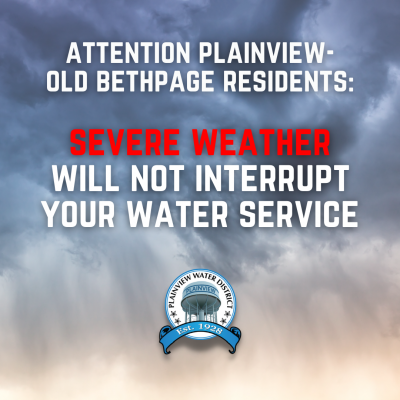New Advanced Oxidation Process Treatment System Specifically Designed to Remove 1,4-Dioxane
PWD Leads Long Island Providers with Most AOP Systems Installed
The Plainview Water District (PWD) is proud to announce that it has recently received approval from the New York State and Nassau County Health Departments to bring an additional Advanced Oxidation Process (AOP) treatment system online. This AOP treatment system is the sixth state-of-the-art treatment system constructed by the District for the removal of 1,4-dioxane from the community’s drinking water and makes the Plainview Water District Long Island’s leader in 1,4-dioxane treatment.
“This is a watershed moment for the District, our community and the quality of its drinking water,” said PWD Chairman Marc Laykind. “We are proud of the leadership this District has shown to expedite the installation of treatment for 1,4-dioxane to meet the new, strictest-in-the-nation standards. The proactivity of our team and the aggressive stance we collectively took to get these systems up and running in an expeditious manner is a testament to our dedication to provide the residents of Plainview-Old Bethpage with the highest quality water possible.”
The latest plant to come online, Plant 3, located on Orchard Street, is a $2.2 million system specifically designed to produce up to two million gallons per day of the highest quality drinking water for the Plainview-Old Bethpage community. The District now has the ability to treat more than 11 million gallons of water every day for 1,4-dioxane. The PWD had begun planning these treatment facilities back in 2018, two years before these regulations were put into effect. Due to their tireless efforts, the District was able to ensure all water being distributed to the community was in compliance with the regulations before they went into effect.
“My fellow commissioners, our staff and our engineers deserve all the credit in the world for getting us to this point in such a short period of time,” said PWD Commissioner Amanda Field. “We have been planning to execute this treatment endeavor for years now as it was always our policy to not seek a deferral from the Health Department and extend the amount of time we had to come into compliance. We met this goal and with the sixth AOP system now online, we have the capacity in place to ensure our residents are always receiving the highest quality water possible.”
AOP treatment systems work by adding a small amount of oxidant (hydrogen peroxide) to the water to create a reaction as it passes through ultraviolet light which ultimately destroys the synthetic chemical. Once the reaction takes place, the water then travels into large Granular Activated Carbon (GAC) filtration tanks to remove any trace amount of oxidant that remain as well as organic and inorganic compounds (such as PFOA and PFOS). This treatment combination of AOP and GAC is the only approved method to remove all of these emerging contaminants by the NYSDOH and local health department.
“If you fail to plan then you plan to fail, which is why we dedicated so much time and resource to ensure our District was well positioned to meet these new water quality standards,” said PWD Commissioner Andrew Bader. “The investments being made now will not only have an immediate impact, but they will benefit the future generations of our community. While we still have a lot of work ahead of us, we take an immense amount of pride in what we have already been able to accomplish.”
The Plainview Water District has been awarded nearly $9 million in infrastructure grant money to construct the necessary AOP treatment facilities. The removal of 1,4-dioxane from wells across Long Island is estimated to cost $1 billion in capital investments with an additional tens of millions per year in increased operating and maintenance costs.


